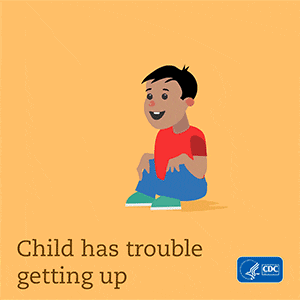CDC and Muscular Dystrophy

The more CDC learns about muscular dystrophy (MD), the more physicians, nurses, and allied health professionals can tailor their care for people living with MD so that each person can reach their full potential. For families and caregivers, understanding more about MD means having the tools to find and provide the best care for their loved ones.
The Centers for Disease Control and Prevention (CDC) works to improve the health and quality of life for individuals with muscular dystrophy. CDC partners with healthcare professionals, university researchers, patient organizations, and state health departments to better understand muscular dystrophy.
Our work focuses on three areas:
- Improving care and services
- Conducting public health research
- Collaborating with partners
Improving Care and Services
Treatment and care for muscular dystrophy varies. In many cases, there are no standard treatment recommendations. CDC works with partners to develop recommendations so that everyone with the condition receives quality health care.
Care Considerations for Duchenne Muscular Dystrophy
CDC convened a group of experts to update clinical care considerations for Duchenne muscular dystrophy (DMD). This collaboration included healthcare professionals who specialize in treating patients with DMD, representatives from patient organizations serving the Duchenne and muscular dystrophy communities, and government agencies. These updated clinical care considerations were published in January 2018 in The Lancet Neurology. Read more about the care considerations for DMD.
Guidelines for Other Types of Muscular Dystrophy
CDC funded the American Academy of Neurology (AAN) to develop treatment and care guidelines for myotonic dystrophy, limb–girdle muscular dystrophy, facioscapulohumeral muscular dystrophy, and congenital muscular dystrophy. The AAN developed these guidelines using evidence from existing medical studies and expert opinion. These guidelines were published and given to healthcare professionals who treat individuals with muscular dystrophy.
Click here to read the AAN guidelines for limb-girdle and distal muscular dystrophy
Click here to read the AAN guidelines for congenital muscular dystrophy
Click here to read the AAN guidelines for facioscapulohumeral muscular dystrophy
Conducting Public Health Research
There is a limited amount of accurate information about muscular dystrophy. CDC funds and manages MD STARnet, the Muscular Dystrophy Surveillance, Tracking, and Research Network. MD STARnet is the only research program designed to collect health information on everyone with muscular dystrophy living in specific areas of the United States. MD STARnet research includes new information on how common muscular dystrophy is, the use of steroids to slow muscle decline, and the mental health of those with muscular dystrophy.
Collaborating with Partners
Early screening, identification, and diagnosis of muscular dystrophy allows individuals and families to plan for the future and make important financial decisions, from choosing a home that is wheelchair accessible, to finding an employer who supports people with disabilities.
Some of the most severe forms of muscular dystrophy begin in early childhood. Many parents spend years taking their child to different doctors before getting a diagnosis of muscular dystrophy. In collaboration with the American Academy of Pediatrics, CDC has developed a web-based tool for parents who are concerned about the physical development of their child. Parents can identify “red flags” they see when their child stands, walks, climbs stairs, holds toys, and other activities. This project is designed to shorten the time to diagnosis.
Read about CDC’s other muscular dystrophy collaborations
Questions?
If you have questions about muscular dystrophy, please email us at: cdcinfo@cdc.gov.
